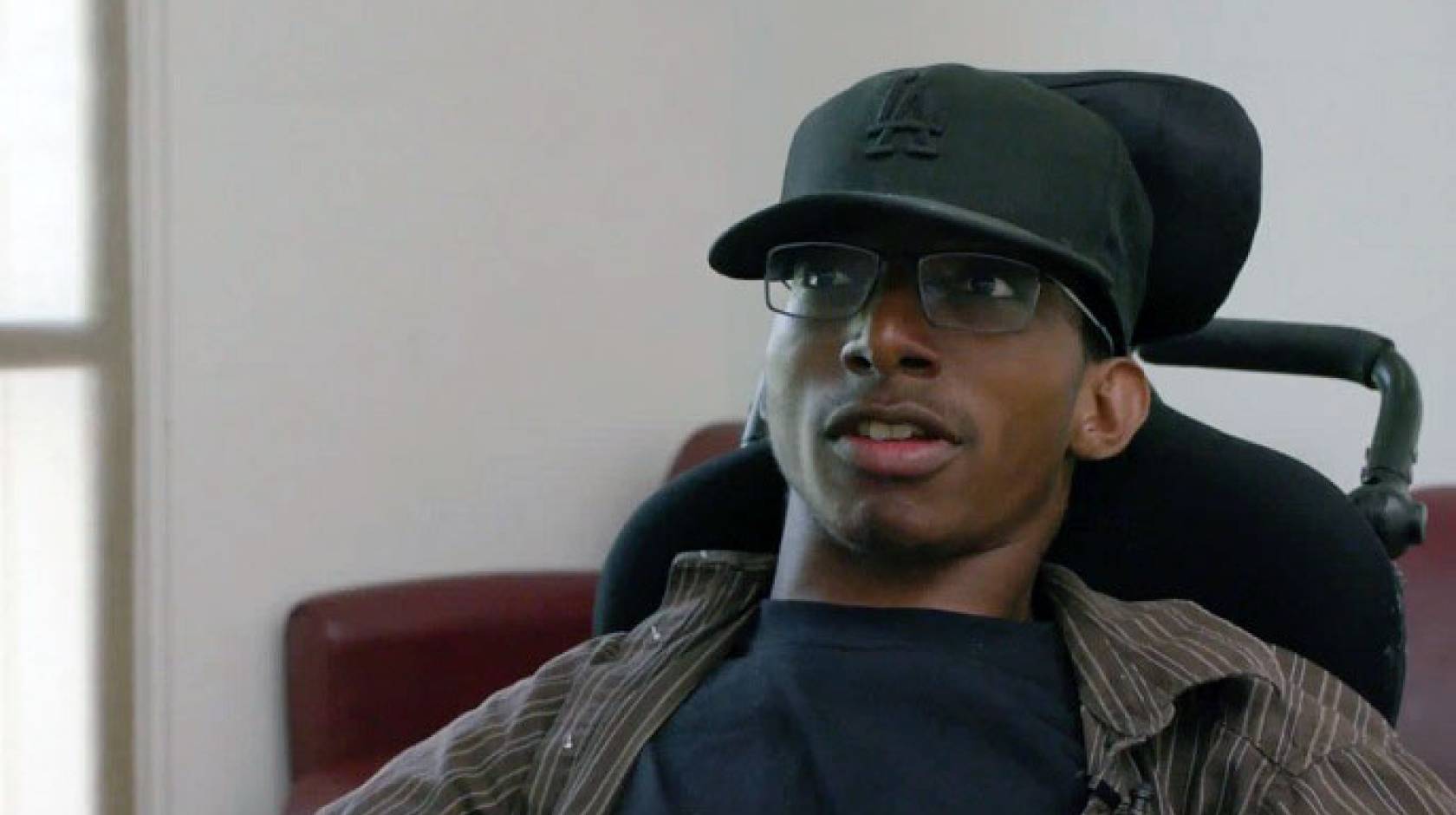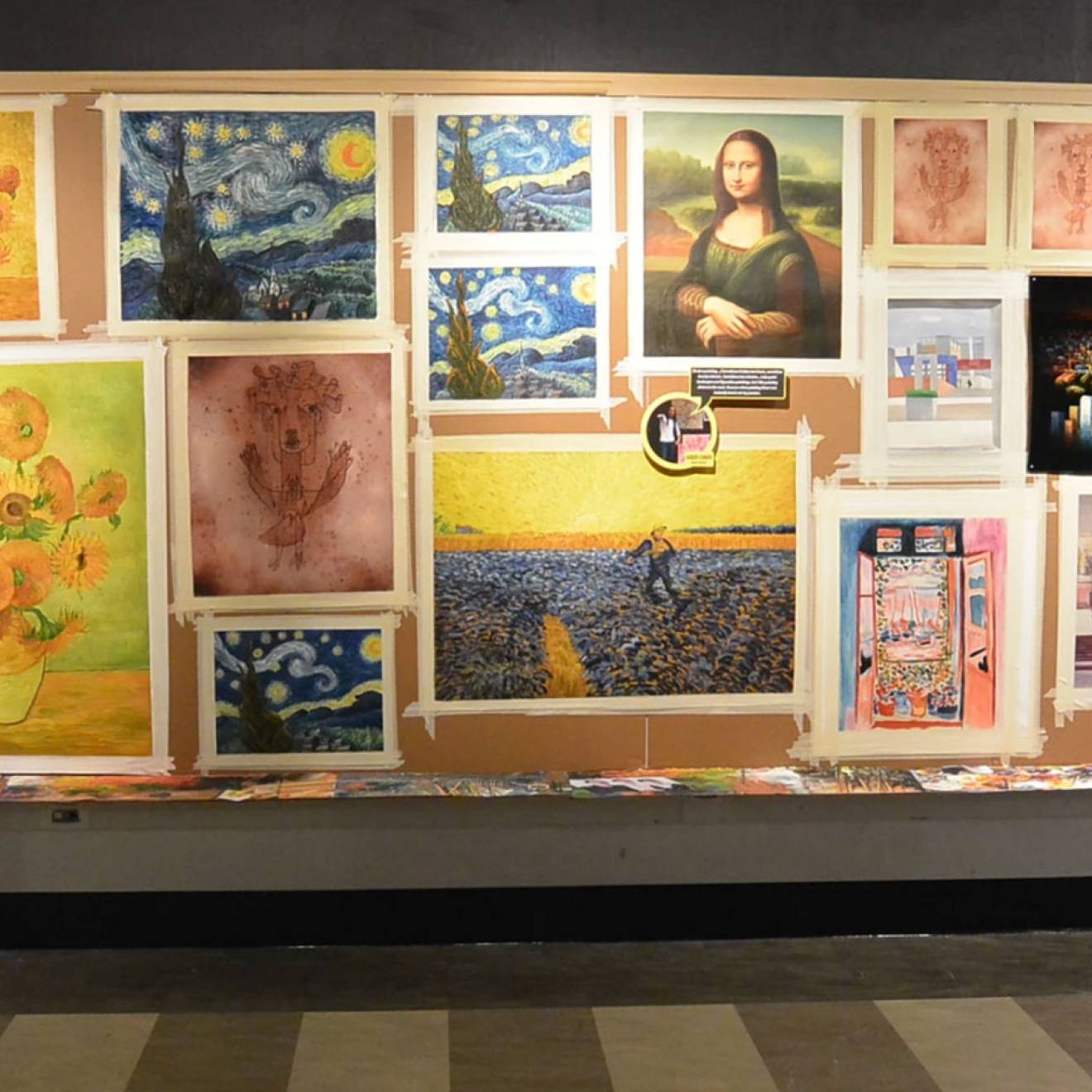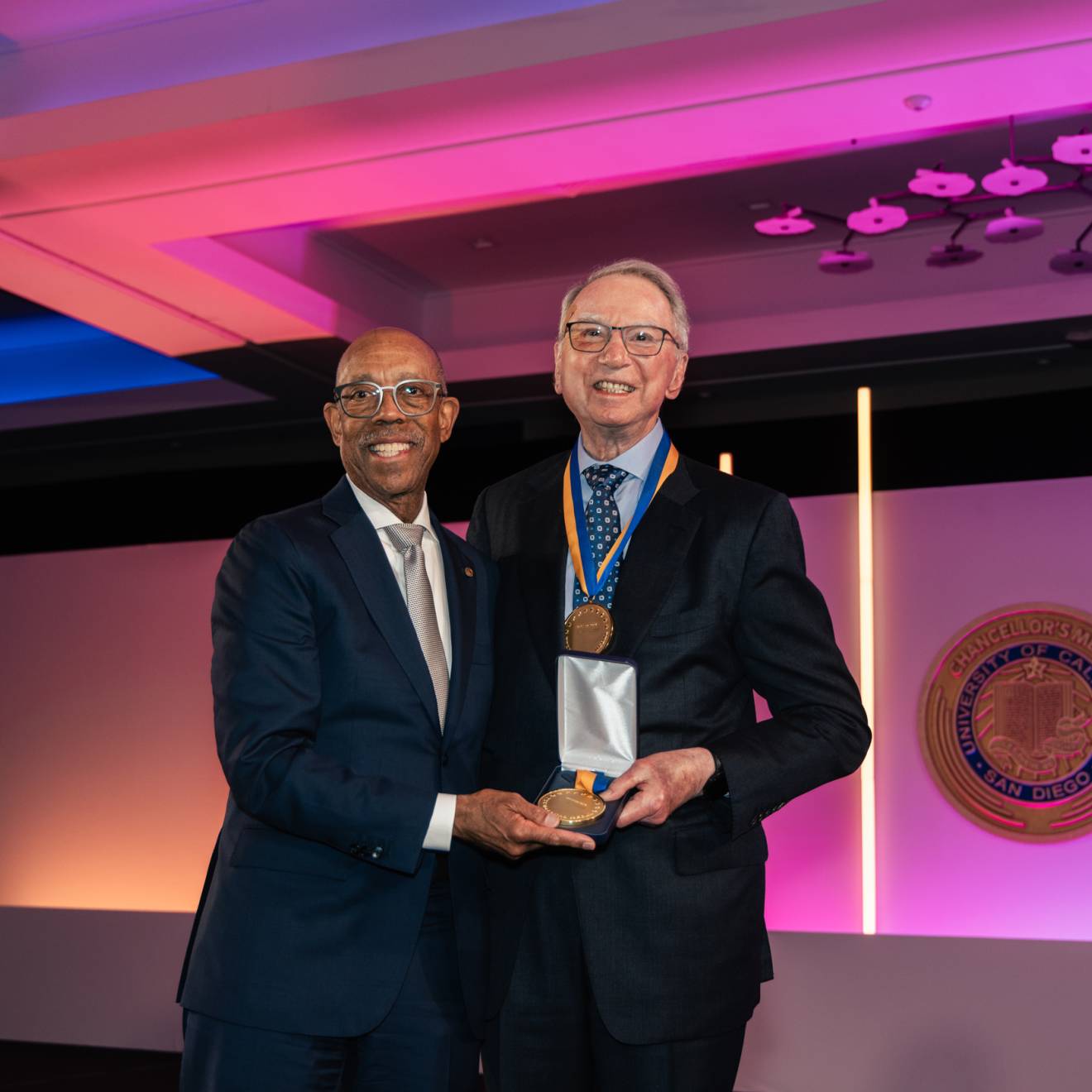Jim Logan, UC Santa Barbara

D’Vonte Johnson has wanted to be a filmmaker since he was 7. The odds have not been in his favor. Born with cerebral palsy, he uses a motorized, custom wheelchair that he controls with a joystick. His voice is halting and raspy.
His mind, though — that’s another story. A fourth-year film and media studies student at UC Santa Barbara, Johnson is bright, focused and knows what he wants.
Just ask Matt DeVogelaere. His simple act of kindness set in motion a cross-campus collaboration of engineering students, a Kickstarter campaign and a crew of supporters committed to finding a way for Johnson to realize his dream of becoming a truly independent filmmaker. They would build the Rally Rig.
“It’s crazy that a few months ago it was an idea, and now that idea is coming to fruition,” Johnson said. “It’s magic almost.”
Credit: UC Santa Barbara on Vimeo
‘This random guy’
The conjuring started like this: A new transfer student from Santa Monica City College, Johnson was in a campus dining commons, alone, when DeVogelaere, a stranger, sat down with him in 2018.
“I was eating on my own and this random guy comes and sits and eats with me,” Johnson recalled. “He wanted to know about my story and just wanted to hang out.”
“That’s something I liked to do when I went to the dining commons — just meet new people,” said DeVogelaere who earned his master’s degree in mechanical engineering in 2018. “I saw D’Vonte just sitting there by himself and decided to sit down and get to know him. I ended up meeting a friend that day.”
After a couple of weeks, Johnson described for DeVogelaere an idea he had for a device that would let him use a film camera. Because Johnson can’t hold a camera, he needed something he could attach to his wheelchair that would cradle a camera and allow him to manipulate it in the usual ways.
The Capstone Program
DeVogelaere could see the proposed device was beyond his skill set, but he had an idea: the UC Santa Barbara Engineering Capstone program, a year-long, project-based course offered to fourth-year engineering students. It pairs teams of students with industry or faculty to engineer a solution to a problem. Medtronic, FLIR, Northrop Grumman and SONOS are just some of the companies involved.
Johnson’s idea — what he would call the Rally Rig — seemed like a good candidate for a Capstone project, so DeVogelaere connected him with Steve Laguette, the program’s academic coordinator and one of its founders.
Personal projects like Johnson’s are a bit unusual, but Laguette had been involved in a couple of other wheelchair challenges. He met Johnson, who explained what he wanted. Laguette liked what he heard.
“This project, we knew we could do,” he said. “This is structural, this is mechanical, and the students took it on.”
The team
The Capstone year starts with a fair, where students select their projects, the first week of classes. Students peruse the various projects and listen to pitches from the companies and researchers behind them. Amanda Singleton and Andrew Lederman, both mechanical engineering majors, knew a little about the Rally Rig, but were sold when Johnson explained what he wanted and why.
“After D’Vonte’s presentation we really felt we knew exactly what he wanted out of this, and it really helped to get in touch with his dilemma,” said Lederman, who noted they hadn’t known the extent of his disability.
“We wanted to be able to help him, and we knew that our skill set aligned with his needs,” Singleton added. Besides, she said, the team wanted to do something personal and meaningful. Nothing wrong with building a sophisticated hand truck for industry, but the Rally Rig offered more. “‘Nah, let’s not do those,’” she said they decided. “Let’s help out D’Vonte.”
Building the rally rig
The team, which also includes mechanical engineering majors Andy Cai, Max Mercurio and Jacob Smith, faced significant challenges in building the Rally Rig. A camera works in three dimensions and requires fine adjustments; how do they allow Johnson to use one if he can’t hold it? What sort of controls would he need to work it, and how do they go together? How do they make it stable when it’s attached to the wheelchair?
Trevor Marks, a research and development engineer in the Department of Mechanical Engineering who serves as advisor to the Rally Rig team, said the project required the students to think in creative ways to adapt a gimbal system for Johnson’s rig. Gimbals are ubiquitous in film shoots because they offer good hand-held stabilization at a reasonable price. How could they make one work for Johnson? The answer: Reverse-engineering an off-the-shelf system.
“They had to get into it and figure out what the internal workings are and then build from that a new device that allows them to interface with it so that it’s accessible now,” Marks said.
Let’s get technical
It took some time and a few missteps, but the team is close to having the Rally Rig ready for its close-up when Johnson unveils it at the Reel Loud Film & Arts Festival Friday, May 24, at UC Santa Barbara’s Campbell Hall.
Built in part at the College of Engineering machine shop, the rig consists of a rigid frame attached to the chair. The camera is attached to an arm that moves up, down and side-to-side via an actuator — basically a piston — manipulated by a joystick at Johnson’s left hand (his right controls his chair). The team designed and printed the rig’s control boards with Marks’s help.
“They worked hard at it,” Marks said. “They’ve had their struggles. By no means is it something that’s simple. And that’s the rewarding part: This project turned out to be a great fit because it’s both something achievable and it’s something that is for a wonderful cause and great person who’ll use it right away. There’s nothing but win.”
For the team, the Rally Rig was more than a project. It was a way to change someone’s life.
“It’ll be pretty awesome seeing him actually being able to film the way he wants to,” Lederman said. “There might be a bit of a learning curve because he’s never filmed like this before, but he’ll be able to get it. And it’s really cool that we’ll actually get to see it in use.”
Money matters
Like any engineering endeavor, building the Rally Rig required money, and not a small amount. The team needed a pricey camera ($3,000), a gimbal ($600), electronics and other materials. Research and development, testing and building the final product wouldn’t be cheap.
So Johnson started a Kickstarter campaign with a goal of raising $7,000. Faculty, staff and friends jumped in to help. Independent filmmaker Allison Anders, a UC Santa Barbara professor of film and media studies, tapped a deep Rolodex for donations of goods from friends in the industry that were used as incentives for people to give to the campaign.
“This was such a great cause and such a wonderful project,” Anders said. “And D’Vonte is himself so inspiring and talented, and his team of engineering students so inventive — it was a cinch to get people to contribute signed Blu-ray discs, books, whole packages of films and music. It was incredibly fun to get folks involved.”
The campaign, now closed, raised $7,966. In addition, the film and media studies department gave Johnson its annual David F. Siegel Award, a $3,000 grant.
A big fan base
Johnson will tell you the Rally Rig couldn’t have happened without an outpouring of support on and off campus. The film and media studies department, which has watched him grow over the past two years, has been a big booster. Joe Palladino, undergraduate advisor and internship coordinator, said Johnson’s heart and dedication to collaboration has made him an ideal student and team member.
“D’Vonte from the very start fit in well, finding teams to work with and then this year building teams around him,” Palladino said. “I think he has talent and ambition and brings his own perspective to the things he takes on. I think that enthusiasm and energy and his sense of humor have kept him and his teams going.”
Chris Jenkins, head of production in the film and media studies department, has taught Johnson in several classes.
“It’s been wonderful having D’Vonte in my production classes, and he’s been a fantastic influence on other students,” Jenkins said. “With sharp skills, a tremendous work ethic and a good sense of humor, D’Vonte has become one of the most sought-after team members for student films. He’s made his mark on a variety of excellent projects and his future is surely going to be filled with more great work. It’s been a true pleasure getting to know him.”
The pull of teamwork
Originally from Inglewood, Johnson had always loved the movies, but a film production class — “some basic thing” — when he was 7 changed the course of his life. Creating something and working as part of team, something he thought was off the table, suddenly became possible.
“Honestly, what really got me into it was how it’s very much relying on the collaboration aspect, since obviously growing up I couldn’t be a part of sports or whatever,” he said. “But seeing that everyone had to work together to create this one vision, it kind made me think, ‘Wow, this is what a team feels like. This is what collaboration feels like.’”
With graduation in sight, Johnson’s thinking of what comes afterward. Graduate school beckons — UCLA or USC, ideally — but the Rally Rig changes the game. It gives him the chance to pursue his own vision for the first time.
“The first thing I want to do is write a script and execute it, all on my own,” he said. “Literally, that’s my goal. I have help, but I don’t want help. I want to do it on my own, just with the benefit of hard work. I just want to try and get the rig out there, and this is just the first step, I hope.”
None of this is a surprise to DeVogelaere, his dining companion. He could see Johnson had goals not just for himself, but for others like him.
“It seems like he’s worked really hard at life,” he said, “and you talk to him for a little bit and you can see this guy has a big heart for other people.”
Building a legacy
To Johnson, the Rally Rig can open doors for others like him, people pushed to the margins and from whom little is expected.
“I’ve always wanted to leave my mark here at UC Santa Barbara, and I felt like the best way to do that is create something that could possibly help other people in my position if they got here,” he said. “Obviously I won’t be able to use the Rally Rig while I’m at school, because it’s a long process. But my hope is that when someone comes here they don’t have to go through that process; it’ll already have it for them.”
As for himself, the future is wide open.
“People don’t get exposed to people like me every day, and I think that with the mind I have and the opportunities, I think I can go as high as I can to show people what’s possible, and that people shouldn’t be looked upon as unable because of their physical appearance,” Johnson said. “So in my mind and with my opportunity, I’m going do everything I can while I can.”

